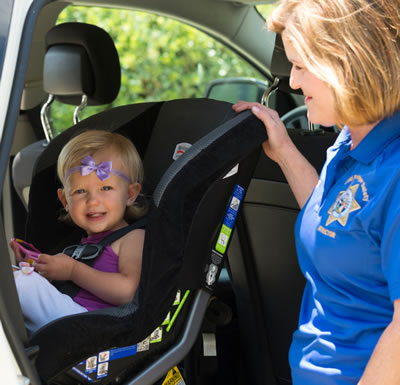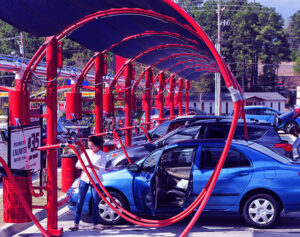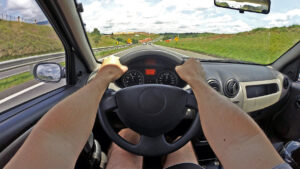California car seat laws state that all children under the age of 8 must be secured in a car seat or booster seat while riding in any moving vehicle. Children who are 8 years old or older, but under the age of 16, must be secured with either a car seat or a safety belt. Additionally, infants and toddlers should ride rear-facing until they reach both 1 year old AND at least 20 pounds before transitioning to forward-facing.
All passengers must wear their seat belts at all times regardless of age and size. Furthermore, child seats must meet federal motor vehicle safety standards and should not be placed in the front passenger side if there is an active airbag present. Lastly, drivers may face fines for violations as well as court appearances depending on the severity of the violation.
California car seat laws require all children under the age of 8 to be properly secured in a car seat or booster seat when riding in any motor vehicle. The type of seat and manner of use depends on their height, weight, and age. Additionally, all children must ride in the backseat until they are at least 12 years old.
It is important for parents to understand these laws so that their children can stay safe while traveling on California roads.
Does My 7 Year Old Need a Car Seat in California?
In California, it is absolutely essential that 7 year olds ride in a car seat while in a vehicle. According to the California Vehicle Code (CVC) section 27363, “Children under 8 years of age and who are 4-foot-9 or shorter must be properly restrained in either a child passenger restraint system or booster seat depending on their size.” This means that any child under 8 years old must be secured with an appropriate fitting safety device such as a five-point harness for younger children and a belt positioning booster seat for older children.
It is important to make sure the car seats meet federal safety standards and can accommodate your 7 year old’s height and weight. As always, following the manufacturer’s instructions is key when installing these devices correctly into your vehicle so you know your little one is safe at all times!
What is the Age And Weight Requirements for Car Seats in California?
In California, the age and weight requirements for car seats are as follows: infants and toddlers must be in a rear-facing car seat until they reach either 2 years of age OR until they reach the maximum height or weight limit designated by the manufacturer. For children between 2 to 4 years old, they must be placed in a forward-facing child safety seat with an internal harness system. After that, from 4 to 8 years old (or up to 4’9″ tall) children should use booster seats with both lap and shoulder belts.
It is important to note that all children under the age of 13 should ride in the back seat of any vehicle. Additionally, whenever possible it is recommended that parents use new or newer model car seats since these will include more recent safety features such as improved padding and energy absorbing materials which increase protection during collisions or sudden stops. Lastly, regardless of their age or size all passengers are required by law to buckle up whenever riding inside a motor vehicle in California!
What are the Height And Weight Requirements for a Booster Seat in California?
Booster seats are an important part of ensuring that young passengers stay safe while riding in the car. In California, there are specific height and weight requirements for booster seats mandated by state law. Generally speaking, a child must be at least 4 feet 9 inches tall or be between 8 and 12 years old before they can use a regular seat belt without the help of a booster seat.
Any child under 8 years old or less than 4 feet 9 inches tall must use an appropriate booster seat with proper lap/shoulder belt fitment. When it comes to weight requirements, many manufacturers list their own limits on their product pages so you should always double-check these when selecting your child’s booster seat. It is also important to note that some vehicles may have lower weight limits which could potentially affect whether your chosen model is suitable for your needs.
When Should I Switch to Booster Seat?
When it comes to transitioning your child from a car seat to a booster seat, there is no one-size-fits-all answer. Generally speaking, the American Academy of Pediatrics recommends that children switch to a belt positioning booster seat when they reach the highest weight or height allowed by their car safety seat’s manufacturer. This can vary widely depending on the make and model of your child’s current car safety seat; you should always check with the manufacturer for their specific guidelines.
Typically though, toddlers will need to transition from a rear facing infant/toddler car seat around age 2 and then move into either a forward facing toddler or convertible carseat until they reach 40 lbs., at which point they should be transitioned into a belt positioning booster. Booster seats are designed for children who have outgrown their regular seats but still aren’t quite tall enough (usually 4’9″) or heavy enough (typically 80 – 100 lbs.)to fit safely in an adult lap/shoulder belt combination without slouching down or having the shoulder strap resting across their neck instead of over their shoulder.
It’s important to note that not all states require boosters so it’s important to check your state regulations before making this transition as well as familiarize yourself with best practices for proper installation and use of both types of restraints prior to switching them out in your vehicle!

Credit: www.chp.ca.gov
When Can My Child Sit in the Front Seat in California
In California, children can sit in the front seat of a car when they are 8 years old or 4’9” tall. It is also recommended that all passengers wear their seat belts regardless of age and height. Additionally, children must be secured in an appropriate restraint system (booster seats) from 4-7 years old and 40-80 pounds.
Booster Seat Age California
In California, children must be in a booster seat until they are 8 years old or 4’9″ tall, whichever comes first. Booster seats reduce the risk of injury during a car accident by 45% for children between the ages of 4 and 8 who use them properly. It’s important to make sure your child is securely fastened into their booster seat in order to ensure maximum safety protection while driving.
When Can My Child Ride Without a Booster Seat
When it comes to deciding when your child is ready to ride without a booster seat, the safest decision is usually based on height and weight. Generally, most children are able to safely transition out of a booster seat at around 4’ 9” tall and between 8-12 years old. However, it’s important for parents to check their state laws as requirements can vary by state and individual vehicle type.
How Much is a Ticket for Not Having a Child in a Car Seat in California
In California, the penalty for not having a child under 8 years old in a car seat or booster seat is $490. This includes any fines and fees associated with the ticket. The law also states that children must be secured properly in an appropriate restraint device based on their age, height, and weight.
Additionally, all children must ride in the backseat until they are at least 13 years of age.
Car Seat Inspection near Me
If you’re looking for a car seat inspection near you, the best place to start is your local fire department. Many fire departments offer free car seat inspections and installation assistance by certified technicians. You can also contact your local police station or hospital to see if they offer similar services.
It’s a good idea to make sure that your child is properly secured in their car seat before every trip, so take advantage of these resources and get yourself peace of mind!
Can a 4 Year Old Sit in a Booster Seat
Yes, a 4 year old can sit in a booster seat. Booster seats are designed to provide extra support for kids who have outgrown regular car seats but aren’t yet big enough to use an adult seat belt alone. The American Academy of Pediatrics recommends that children remain in the appropriate booster seat until they reach 57 inches tall (4 feet 9 inches) and are between 8 and 12 years of age.
Booster Seat Requirements
Booster seats are an important part of keeping your child safe in the car. Depending on the state you live in, there are different laws and requirements for booster seat use. Generally, children must be at least 4 years old or 40 pounds before they can transition from a car seat to a booster seat.
However, some states have stricter regulations such as requiring all children under 8 years old or 80 pounds to remain in a booster seat until they reach those milestones. It is important to check with your local DMV or Department of Motor Vehicles for specific booster seat requirements and safety guidelines in your area.
When Can a Child Sit in the Front Seat
Once a child has reached the age of 12, they can legally ride in the front seat as long as it is equipped with an appropriate safety belt. It is important to note that various states have different laws regarding when a child is allowed to ride in the front seat, so it’s best to check your local regulations first. Additionally, some car manufacturers may recommend keeping children under 12 years old in the back seat until they are taller than 4 feet 9 inches for optimal protection against airbag deployment.
Conclusion
In conclusion, California car seat laws are an important part of keeping children safe while traveling in vehicles. It is a parent’s responsibility to ensure that their child is properly restrained and following the rules outlined by the state of California. By staying up-to-date on these regulations, parents can rest assured that they are doing what they can to keep their little ones safe when on the go.






